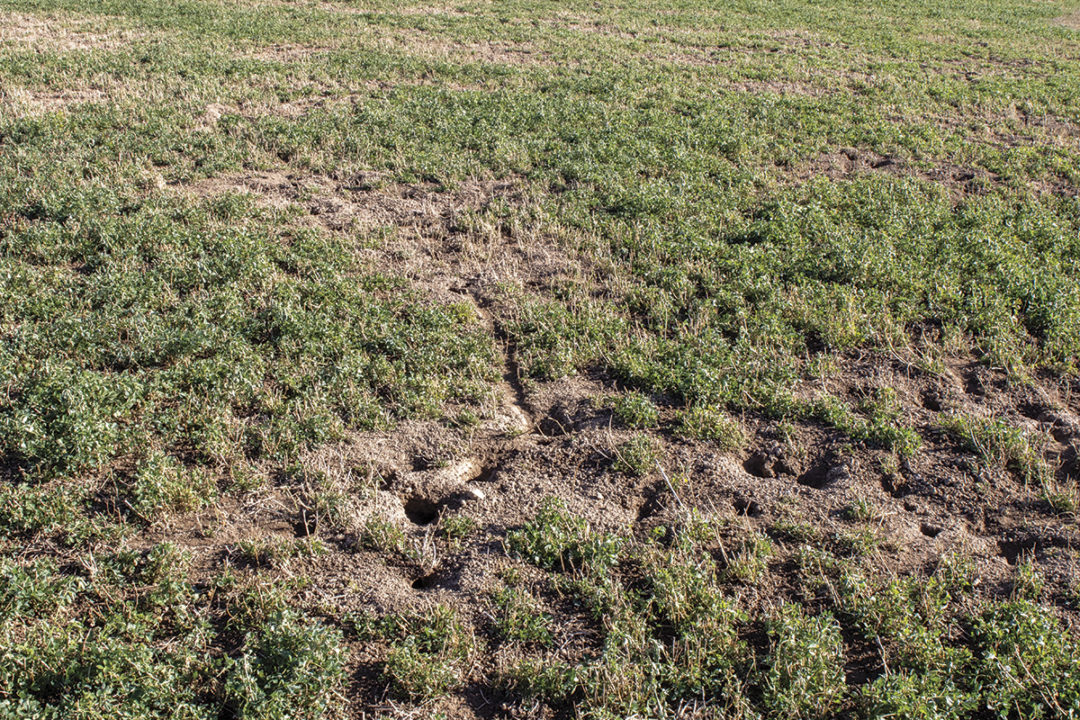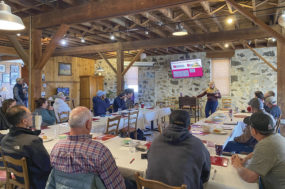Voles have been in Idaho since the pioneers came across 170 years ago – and even long before that. While many wildlife species have needed human intervention to sustain their populations, other species have thrived with the introduction of modern human agriculture and residential suburbs. Voles seem to have an appetite for well-watered perennial systems that are nutrient-rich, such as alfalfa, pasture and lawns. They are active year-round, and often the damage they cause throughout the winter is not seen until after the snow melts to reveal their mud tunnels. The last few years have been great examples of what happens when their populations balloon to epidemic levels.
I was invited to a meeting last October with a bunch of farmers who also invited legislators, representatives from the Idaho Fish and Game, and local chemical suppliers. They all came together to discuss the vole issue that isn’t new but is constant. Farmers had had enough. Their fields have taken a beating to the extent that something needs to be done. This group of local farmers gathered to let their elected representatives know about the biggest problem facing them: voles.
A vole looks harmless enough. They are short-tailed mice with small ears. To hawks and coyotes, they are the perfect snack size. They build burrows and runways that are not always completely underground. Unlike house mice, they prefer green vegetation over breadcrumbs and peanut butter, but they aren’t picky. They will eat whatever is available to them, and quite often what is available is farm crops or pasture. They are native to Idaho and have been here since ground was first turned 150 years ago. So why are they a problem now?
The truth is: This problem didn’t happen overnight. In fact, this isn’t the first year voles have caused issues for farmers. Vole populations tend to fluctuate, and they have adapted to have a large boom in their population every five to 10 years to keep the predator population guessing about food availability. As the predator populations and disease pressure increase, the populations typically crash and start the cycle over again. In 2020, there was a huge influx of vole populations. The population was expected to go down again. However, you can’t always predict what happens in nature. The population failed to crash in 2021. The year 2022 was worse, so much so that the farmers sought help from their elected officials. The governor was even invited out to tour the damage from a helicopter.
To make matters worse, options are limited for vole control. The best tool in the toolbox is a rodenticide called zinc phosphide. Zinc phosphide has its issues. When zinc phosphide gets wet, it creates a toxic gas which kills the rodents. In a correct application, zinc phosphide should stay dry until the animal gets it wet by eating it. But rain, dew or even high humidity can render zinc phosphide useless, making a very narrow window for proper application. Applications often fail for a variety of factors, causing more costs for the producer with little results. Zinc phosphide is a restricted-use chemical and can only be applied by those who have a license to do so. Organic producers are even more pinched. They are basically left to the whims of Mother Nature, with hopes the population crashes before the crop is completely destroyed.
Natural means of control often come too little too late. Predators cannot keep up with the surplus of food. Badgers, coyotes and raptors all tend to increase in population size, but only after the damage to crops is done. Diseases can spread through populations but are hardly dependable or predictable. Natural controls are often considered to be independent from most control plans used by farmers. It is comforting to see feral cats with a mouthful of vole fur, but hay producers are desperate for something that has a little more effectiveness or predictability.
A quick survey was taken of the farmers in that meeting in October. Out of the 56,000 acres managed in that meeting, 39,000 were said to have “severe” vole damage. Farmers estimated they had lost 27.9% of their yields from vole damage alone. That can be the nail in the coffin for farms that are operating on profit margins in the single digits. Those numbers don’t tell the whole story. Many farmers have experienced such heavy damage on their last crop that they are contemplating ripping out their alfalfa for another crop. Planting a pivot of alfalfa can cost tens of thousands of dollars, and it is supposed to last for five to 10 years. When a new field that was planted last year must already be replaced, the value returned from that investment is severely diminished.
A cold winter with little snow cover would be best to bring down the vole populations. Unfortunately, that is counterintuitive for the moisture needed for the crops typically damaged by voles. The last few years, voles have been a huge problem for the Mud Lake/Terreton/Monteview area, but these population booms can happen anywhere. Blackfoot, Pocatello and Twin Falls all experience similar cycles, but not at the same time. As time progresses, voles seem to be a constant yet inconsistent issue for the average Idaho farmer. Hopefully, these populations will come down and technology will advance to help address this endemic pest.






